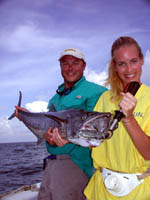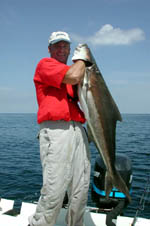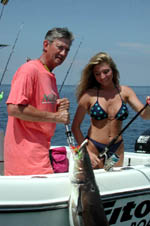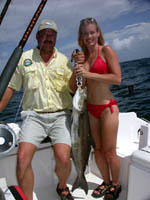
|
Features
|
|
|
|
Books
|
|
|
|
Fun & Games
|
|
|
|
Contact Us
|
|
|
John's Journal... Entry 195, Day 2
THREE-STORY FISHING
What's On Top
 EDITOR'S
NOTE: You can catch more fish and have more fun
if you know how to fish all three stories of the water. On a family outing
to Orange Beach, Alabama, my family and friends had rod-bending action
all day.
EDITOR'S
NOTE: You can catch more fish and have more fun
if you know how to fish all three stories of the water. On a family outing
to Orange Beach, Alabama, my family and friends had rod-bending action
all day.
Reefs and wrecks attract a wide variety of fish. You'll usually find the pelagic species like king mackerel, cobia and Spanish mackerel in the top story of water, from the surface to 20 or 30 feet down. Although free-roaming, these fish will move onto a reef or a wreck and feed on the baitfish that hold high in the water above the wreck. In the top of the stack, you also may catch large red snapper, gray snapper and amberjack. However, these fish generally will start biting after you begin bringing fish up from the bottom. Often, snapper and amberjack will follow the fish you reel in to the surface, and you can catch them. But king mackerel and cobia will remain your primary targets.
 To
take these fish, most captains prefer to use spinning-gear tackle to allow
anglers to cast out the line from the boat without interfering with the
anglers bottom fishing. You can utilize a reel that has the capacity of
holding more than 100 yards of 20-pound-test line. At the end of the line,
tie on a barrel swivel. Then attach 2 1/2-feet of braided wire leader
and a no. 4/0 Mustad treble hook. "We like to drift (fly-line) a dead
cigar minnow for king mackerel schooling above the sunken cars and other
man-made reefs on the bottom," Walker explained. "We put the rod in a
rod holder with the drag set tight enough to set the hook but not too
tight to tear the fish's mouth." When the fish hits, anyone on-board can
pick up the rod and battle the fish. You let the fish peel off as much
line as it wants, especially to tire out a king mackerel. Then when you
bring the king to the boat, it can come to the gaff laying on its side
and not have enough energy to tangle the other lines on the boat."
To
take these fish, most captains prefer to use spinning-gear tackle to allow
anglers to cast out the line from the boat without interfering with the
anglers bottom fishing. You can utilize a reel that has the capacity of
holding more than 100 yards of 20-pound-test line. At the end of the line,
tie on a barrel swivel. Then attach 2 1/2-feet of braided wire leader
and a no. 4/0 Mustad treble hook. "We like to drift (fly-line) a dead
cigar minnow for king mackerel schooling above the sunken cars and other
man-made reefs on the bottom," Walker explained. "We put the rod in a
rod holder with the drag set tight enough to set the hook but not too
tight to tear the fish's mouth." When the fish hits, anyone on-board can
pick up the rod and battle the fish. You let the fish peel off as much
line as it wants, especially to tire out a king mackerel. Then when you
bring the king to the boat, it can come to the gaff laying on its side
and not have enough energy to tangle the other lines on the boat."
 In
recent years, Florida has banned the netting responsible for a tremendous
number of the king mackerel harvested in years past. The Gulf Coast Fisheries
Council working with the National Marine Fisheries Service has set up
length and bag limits. Today sportsmen will find more king mackerel available
for the catching than in previous years. The 2003 regulation on king mackerel
reads the fish must have at least a 24-inch length for the angler to keep
the fish. Also an angler can't have more than two in his or her possession.
The Spanish mackerel limit stands at 15 per person with no length limit.
In
recent years, Florida has banned the netting responsible for a tremendous
number of the king mackerel harvested in years past. The Gulf Coast Fisheries
Council working with the National Marine Fisheries Service has set up
length and bag limits. Today sportsmen will find more king mackerel available
for the catching than in previous years. The 2003 regulation on king mackerel
reads the fish must have at least a 24-inch length for the angler to keep
the fish. Also an angler can't have more than two in his or her possession.
The Spanish mackerel limit stands at 15 per person with no length limit.
As we went by a buoy out in the gulf on the day we fished with Captain Bobby Walker, he instructed his deckhand to bait three of the spinning rods with live pinfish and told our crew to cast to the buoy. As soon the live pinfish hit the water, three cobia, two in the 50-pound range and one that weighed 80 pounds or more, came out to eat the baits. "Let them take the bait and swallow it before you set the hook," Walker coached from the bridge. I saw the rods held by the two anglers on my left bend to the hard charge of the two 50-pound cobias. But because the big fish had headed straight for my bait, I had to concentrate all my attention on the fish and the bait. After the big, brown bomber inhaled the pinfish, I let the cobia take the slack out of the line as it turned its head sideways to swim off. Then I set the hook.
 The
heavy cobia swam quickly back to the buoy as the line sang a tune and
sped off the reel. But in a fleeting instant, the monofilament that held
the hook fast to the cobia's jaw passed against the buoy chain. As the
line jumped back towards me limply, I heard Walker say, "that fish is
big because nobody's even gotten him close to the boat yet. You're the
third angler in the last five weeks who's been hooked up to him." But
the misses and near-misses you have when three-story fishing add to the
fun and excitement.
The
heavy cobia swam quickly back to the buoy as the line sang a tune and
sped off the reel. But in a fleeting instant, the monofilament that held
the hook fast to the cobia's jaw passed against the buoy chain. As the
line jumped back towards me limply, I heard Walker say, "that fish is
big because nobody's even gotten him close to the boat yet. You're the
third angler in the last five weeks who's been hooked up to him." But
the misses and near-misses you have when three-story fishing add to the
fun and excitement.
For more information on how to fish three stories of water simultaneously, contact Captain Bobby Walker, P.O. Box 100, Orange Beach, AL 36561, or call (251) 981-6159. You can contact the Alabama Gulf Coast Convention and Visitors Bureau at 1-800-745-7263 or www.gulfshores.com.
TOMORROW: AMBERJACK IN THE MIDDLE
Check back each day this week for more about THREE-STORY FISHING ...
Day 1 - Heading Out for
Three-Story Fishing
Day 2 - What's On Top
Day 3 - Amberjack in the Middle
Day 4 - Reds and Triggers on the Bottom
Day 5 - All-Day Rod Bending